► Living with an electric Mini
► Cool looks but short range
► Will either matter to James?
Six months ago I wrote my first Mini Electric report with a half-empty glass on my desk. I’m writing the report sipping a half-full one. Life with the Mini has been challenging at times but it’s been nice having it around.
It’s been liberating to pop into town without the guilt of starting a cold engine for a short journey. And it’s very easy to use: get in, go, and enjoy the drive. The Mini feels more analogue than most electric cars, like a normal car with a powerful electric motor instead of an engine. That’s exactly what it is.
Engineering an electric production car is no easy task, and it can’t have been simple to adapt the existing Mini to carry an EV powertrain (and to go down the same production line as the rest of the range). The downside of squeezing a square (well, T-shaped) battery pack into a rounded supermini is the range. Officially, it’ll manage up to 145 miles from a full charge. On dual carriageways, even sticking to 60mph, I struggled to crack 100 miles.
Not being able to charge at CAR’s offices during lockdown has meant three-pin-plug charging at home. Lacking the ability to charge overnight at my mid-terrace house meant I had to adapt my life to the Mini. On the eve of a big motorway journey, for example, I cancelled plans to drive to meet friends because I needed the battery full of charge for the morning.
On the move, conversely, 50kW fast-charging capability means it’s possible to refill the Mini very rapidly, provided you can find an available site.
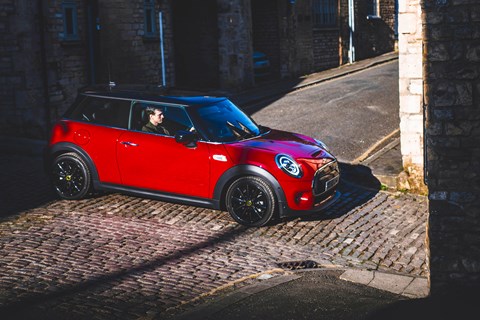
The type of worst-case scenario that makes people think twice about EVs did happen during my time with the Mini: a long-ish, urgent journey to help a family member who had fallen ill. The Mini had more than 80 per cent charge at the time, and made it with mileage to spare; had the car happened to have been half-empty or less, I wouldn’t have completed the journey. I also needed to have an unscheduled stay overnight to get enough charge in the Mini to make it home the next day.
I later swapped cars for a couple of weeks with editor Ben Miller, who does have overnight charging capability (albeit also through a three-pin plug), and the Mini suited him just fine (and me, since I borrowed his Aston Martin).
Running the Mini has confirmed my thoughts that I can’t go fully electric unless I move, adapt my existing home, or go for an EV with a bigger range. The Honda E might be a more inventive, individual car, and it beat the Mini in our Giant Test, but it has an even titchier range.
Next year, Mini expects a third of three-door hatches built at its Oxford plant to be electric. Mileage aside, its appeal is undeniable. The Mini Electric’s sheer normality is its greatest strength. If the odd styling and the curious driving experience of EVs has previously put you off, this could be the car to change your mind – provided you plan ahead for long journeys.
Logbook: Mini Electric Level 3
Price £24,900 (£30,900 as tested, after plug-in grant)
Performance 32.6kWh battery, single e-motor, 181bhp, 7.3sec 0-62mph, 93mph
Efficiency 3.9 miles per kWh (official), 3.9 miles per kWh (tested), 0g/km CO2
Energy cost 4.6p per mile
Miles this month 422
Total miles 2803
Month 5 living with a Mini Electric: cables everywhere!
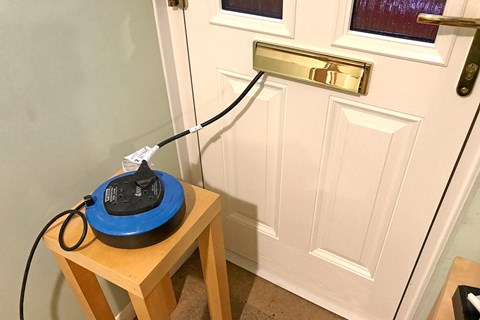
Like having a new pair of white trainers, I feel a bit guilty routing the Mini’s smart charging cable through the muck of a rain-grimed path or driveway. And much like walking onto carpet from outdoors on a rainy day without taking your shoes off, I feel a bit guilty lobbing it straight into the boot afterwards if I’m in a hurry. Recently it’s been snaking through letterboxes and under garage doors while I’ve been away visiting family and beg-borrowing their plug sockets.
In other news, last week the Mini Connected app came over a bit Y2K and told me the car’s current location was Berlin…
Logbook: Mini Electric Level 3
Price £24,900 (£30,900 as tested, after plug-in grant)
Performance 32.6kWh battery, single e-motor, 181bhp, 7.3sec 0-62mph, 93mph
Efficiency 3.9 miles per kWh (official), 3.7 miles per kWh (tested), 0g/km CO2
Energy cost 4.8p per mile
Miles this month 314
Total miles 2381
Month 4 living with a Mini Electric: the slow movement
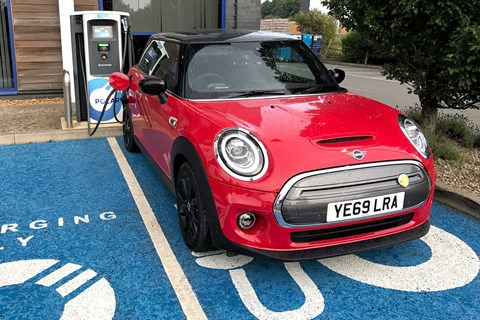
I shirked my responsibilities last month and dodged the bullet of an early-morning, long-distance motorway voyage in the short-range Mini by borrowing Jake’s long-term Mazda 3. I repented this month by using the Mini to make a 250-mile round trip from Lincolnshire to Buckinghamshire to get to the launch of the updated Alfa Romeo Giulia Quadrifoglio. I made it there and back without getting stranded but it did mean charging up three times: once on the way down, once at the launch venue and once on the way home.
The Mini’s battery was on 99 per cent when I left home, and reckoned on a 125-mile range in miserly Green+ mode (no air-con, feather-footed accelerator pedal response) for the 115-mile journey when I set off. But at the bottom of my road it flashed a warning that it would have insufficient charge to reach the destination. No problem; I was smugly expecting this, and had given myself an extra hour in hand. Plan A, to top up at a motorway services en route, was thwarted when I couldn’t get the supplier’s app to strike up a fluent conversation between the charge point and the Mini. But Plan B, a tip from a colleague, saved the day. In Kings Langley, a few minutes from the motorway, there’s a rapid CCS charger that lobbed dozens of miles of range into the Mini in a few minutes.
On the way back, I trusted the Mini’s own sat-nav to help, and it found me a rapid charger near Kettering. I made it home having spent a couple of hours longer in transit than I would have done in a piston-powered car.
Next day, with the Mini’s battery depleted, I ventured out in search of another public rapid charger closer to home. It was operated by a supplier I hadn’t used before, and needless to say signing up for an account and getting it authorised was long-winded and unsuccessful, though the charger did manage to charge my credit card… Time to head home and begin the rigmarole of charging through my kitchen window again instead.
By James Taylor
Logbook: Mini Electric Level 3
Price £24,900 (£33,900 as tested)
Performance 32.6kWh battery, single e-motor, 181bhp, 7.3sec 0-62mph, 93mph
Efficiency 3.9 miles per kWh (official), 3.9 miles per kWh (tested), 0g/km CO2
Energy cost 4.6p per mile
Miles this month 422
Total miles 2067
Monh 3 living with a Mini Electric: you’re on the bench
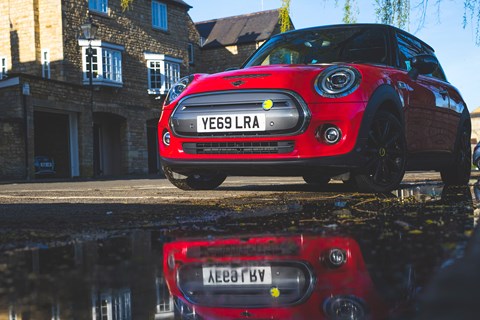
I’m afraid I’ve failed you already. Back in Month 1 I promised I’d use the Mini as my main car as much as possible. But this month I needed to do a 120-mile journey to arrive somewhere early to pick up a car I can’t tell you about yet for a photo shoot appearing in a future issue. I knew the Mini would need charging en route, which would have meant leaving even earlier and being beholden to the reliability of public motorway chargers. So I caved, and swapped with a colleague for another new car I can’t tell you about yet, with pistons and a petrol tank.
When I have done long journeys in the Mini, it’s been a tolerable motorway companion but not an ideal one, with a fair bit of tyre roar and background boom. Most trickily, though, dual-carriageway driving invariably means you don’t get beyond double-figures mileage before the battery needs a top-up.
By James Taylor
Logbook: Mini Electric Level 3
Price £24,900 (£33,900 as tested)
Performance 32.6kWh battery, single e-motor, 181bhp, 7.3sec 0-62mph, 93mph
Efficiency 3.9 miles per kWh (official), 3.9 miles per kWh (tested), 0g/km CO2
Energy cost 4.7p per mile
Miles this month 192
Total miles 1645
Month 2 living with a Mini Electric: here, there, everywhere
Plugging away
I’ve been keeping the Mini topped up by negotiating times I can block my neighbours’ driveway to snake a three-pin lead out of my kitchen. It’s a lengthy process to do in one go. To get from zero (not that I plan on running it that low) to 80 per cent takes 12 hours.
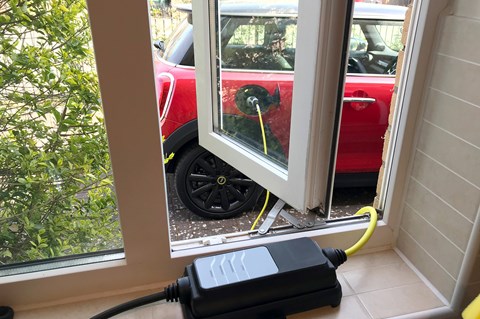
Rough with the smooth
Ride comfort is on the firm side, which is fine by me. Makes perfect sense if you think of the Electric as a warm hatch. Multi-link rear suspension helps keep body movements nicely controlled.
Tailswings and roundabouts
The Mini can’t help revealing its cheeky side on a deserted roundabout. Centre of gravity is a smidge lower than engine-powered Minis, and since the motor is a bit lighter than an engine the weight distribution’s a little sweeter too (although you are carrying an extra 145kg overall). Let’s do an extra lap…
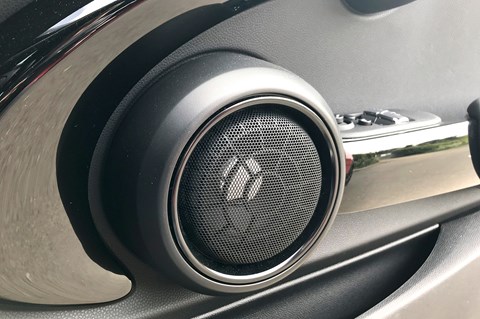
What’s that sound?
In the absence of pistons thrashing away, the Electric makes an artificial noise at low speeds, so that you know it’s running (via the cabin’s speakers) and so do pedestrians (via a hidden external speaker). It’s a curious sound, a bit like a small spacecraft docking, or a slightly mournful cyborg sighing.
Pedal-pushers
Can’t imagine accelerator pedal software calibration engineers get many shout-outs, so here’s one: the Mini Electric’s is amazing. Creeping millimetre by millimetre up to obstacles in tight parking spaces, gunning down sliproads or cruising in the outside lane, it’s incredibly precise. Big up yourselves.

Small boots to fill
The Electric has exactly the same small boot as a regular Mini. The passenger footwell becomes a second boot for surplus bags on a medium-sized food shop.
By James Taylor
Logbook: Mini Electric Level 3
Price £24,900 (£33,900 as tested)
Performance 32.6kWh battery, single e-motor, 181bhp, 7.3sec 0-62mph, 93mph
Efficiency 3.9 miles per kWh (official), 3.5 miles per kWh (tested), 0g/km CO2
Energy cost 4.7p per mile
Miles this month 138
Total miles 1453
Month 1 living with a Mini Electric: hello and welcome
As potential EV customers go, I’m what you’d call a hard sell. I frequently need to do long journeys at the drop of a hat; I live in a mid-terrace house without space to park outside, so I can’t easily charge at home; I have a garage but it isn’t joined to my house and there’s no power to it, so I can’t fit a wallbox charger; and I’m a worrier by nature, so if anyone’s going to suffer from range anxiety attacks, it’s definitely me.
Treating the new Mini Electric, with a mileage range to match its name, as my primary car is going to be a challenge for both the car and for me. But in the spirit of adapting to change, I like to think I’ll come out of the experience the better for it, and it will give the car a chance to show what it can do beyond its design brief.
A more typical Mini Electric user would be part of a household with home-charging capacity and with more than one car. Based on research that shows the average distance driven by most drivers on a typical day is 26 miles, the Mini Electric’s WLTP-rated range of up to 145 miles should be entirely practicable for its target users.
Getting near that figure in real life is proving difficult, however. You’ll recognise this car from the London adventure elsewhere in this issue, its first proper journey. I set off from the office, 90 miles from central London, with a full battery but in less-than-ideal cold weather. There are four different driving modes: Sport, Mid, Green and Green+. In the latter, which deactivates the air-con and seat heating, the estimated range suggested 104 miles. In Green mode (it was cold, I needed the heater), it dipped to double figures.
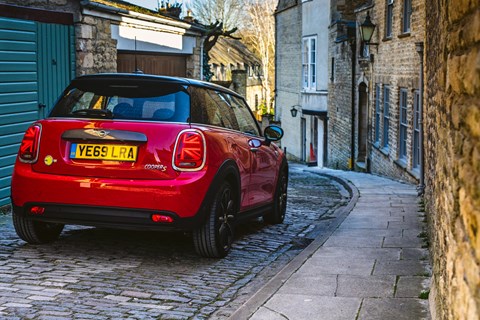
Despite driving well below the national speed limit, it needed a quick top-up at a motorway services to be sure of reaching our destination, and then topping up overnight at a roadside charger.
And then after the next day’s photography in London, I had to charge it again during the return journey to Peterborough. So motorway journeys are definitely not this car’s forte.
I do have access to a petrol car for emergencies, and I’ll need to drive numerous other cars during the course of work, but I’m aiming to use the Mini as my main car as much as possible. I live around 15 miles from the office, where there are charging points. So on days when I’m at my desk (remember those?), it’ll be more than manageable. But there aren’t that many normal days in this job, and at the time of writing (from my kitchen table), normal days in general are in short supply.
Our Mini Electric is a Level 3, top of the trio of trim levels, chiming in at £33,900 post plug-in grant. A basic Level 1 costs £24,900, comparing favourably with a regular petrol three-door Mini Cooper S auto, which would cost around £22,285 in base spec. Mini expects most customers to lease the car, however, with its own rates starting below £300 a month.
All cars get sat-nav, Apple CarPlay/Android Auto and cruise control, and Level 2’s enlarged toy box includes speed-limit info, high-beam assist, heated seats and a reversing camera. For the extra dosh over a base Electric, our Level 3 spoils us with a head-up display, larger touchscreen for its expanded sat-nav system, more parking sensors and full leather upholstery.
But think of the bigger financial picture. According to Mini’s maths, conducting my average commute under electric power could save me up to £56 a month over a comparable petrol car. Some rudimentary arithmetic based on the miles I’ve been able to cover so far, factoring in the pricey public charging during the trip to London, puts the estimated cost per mile at 6.5p less than my Lexus RC 300h averaged.
I’ve driven a good few electric cars in this job but I’ve never run one day-to-day, week-in, week-out. My personal growth starts here.
Our Mini’s spec choices
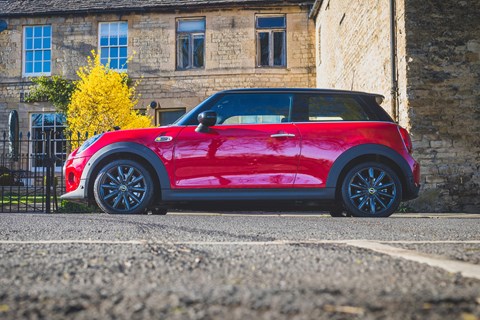
Badge and gun
In the UK this car is called the Mini Electric but it’s known as the Cooper SE elsewhere. With 199lb ft available, it’s swift enough to wear the traditional performance badge with at least some authenticity.
Art attack
Mini Electric buyers can mix and match body, roof and mirror colours and wheel designs at no extra cost. Level 1 cars are silver or grey. Level 3 gets a choice of six hues. This is Chili Red, which can’t be had with the Electric’s optional yellow trim pieces, to avoid a Rupert the Bear situation.
Wheels keep it real
The Electric’s showpiece wheel option is a three-pin-plug design (originally called, believe it or not, Corona Spoke) but our test car has these more demure Minilite-style Cosmos Spoke wheels. At 17 inches, they’re as large as Mini Electric rims go.
Level up
Or go without. Paint and wheels aside, Mini isn’t offering individual cost-options for the Electric, so the kit that comes with each level is the kit you get. If you want a head-up display, for example, it’s Level 3 or bust. If you don’t fancy a Union Jack dash motif, best stick at Level 2.
Logbook: Mini Electric Level 3
Price £24,900 (£33,900 as tested)
Performance 32.6kWh battery, single e-motor, 181bhp, 7.3sec 0-62mph, 93mph
Efficiency 3.9 miles per kWh (official), 3.4 miles per kWh (tested), 0g/km CO2
Energy cost 10.3p per mile
Miles this month 302
Total miles 1315